Nursing Assignment: Aseptic Techniques in Drain Tube Removal
VerifiedAdded on 2022/12/21
|7
|1553
|7
AI Summary
This nursing assignment discusses the importance of aseptic techniques in removing drain tubes from the stomach. It highlights the steps to maintain hygiene and prevent infection during the process. The assignment also covers the evaluation, analysis, and action plan for future practice.
Contribute Materials
Your contribution can guide someone’s learning journey. Share your
documents today.
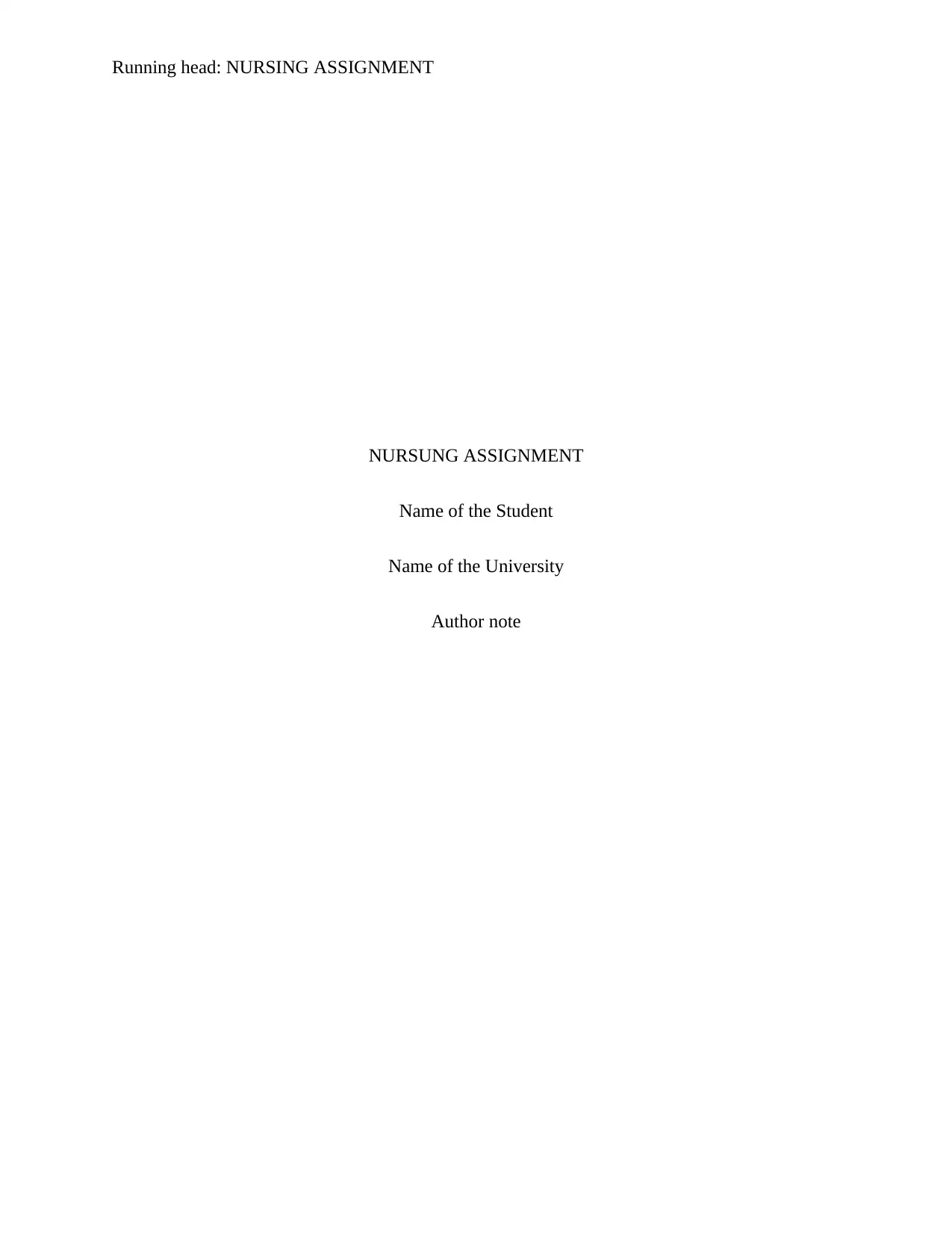
Running head: NURSING ASSIGNMENT
NURSUNG ASSIGNMENT
Name of the Student
Name of the University
Author note
NURSUNG ASSIGNMENT
Name of the Student
Name of the University
Author note
Secure Best Marks with AI Grader
Need help grading? Try our AI Grader for instant feedback on your assignments.
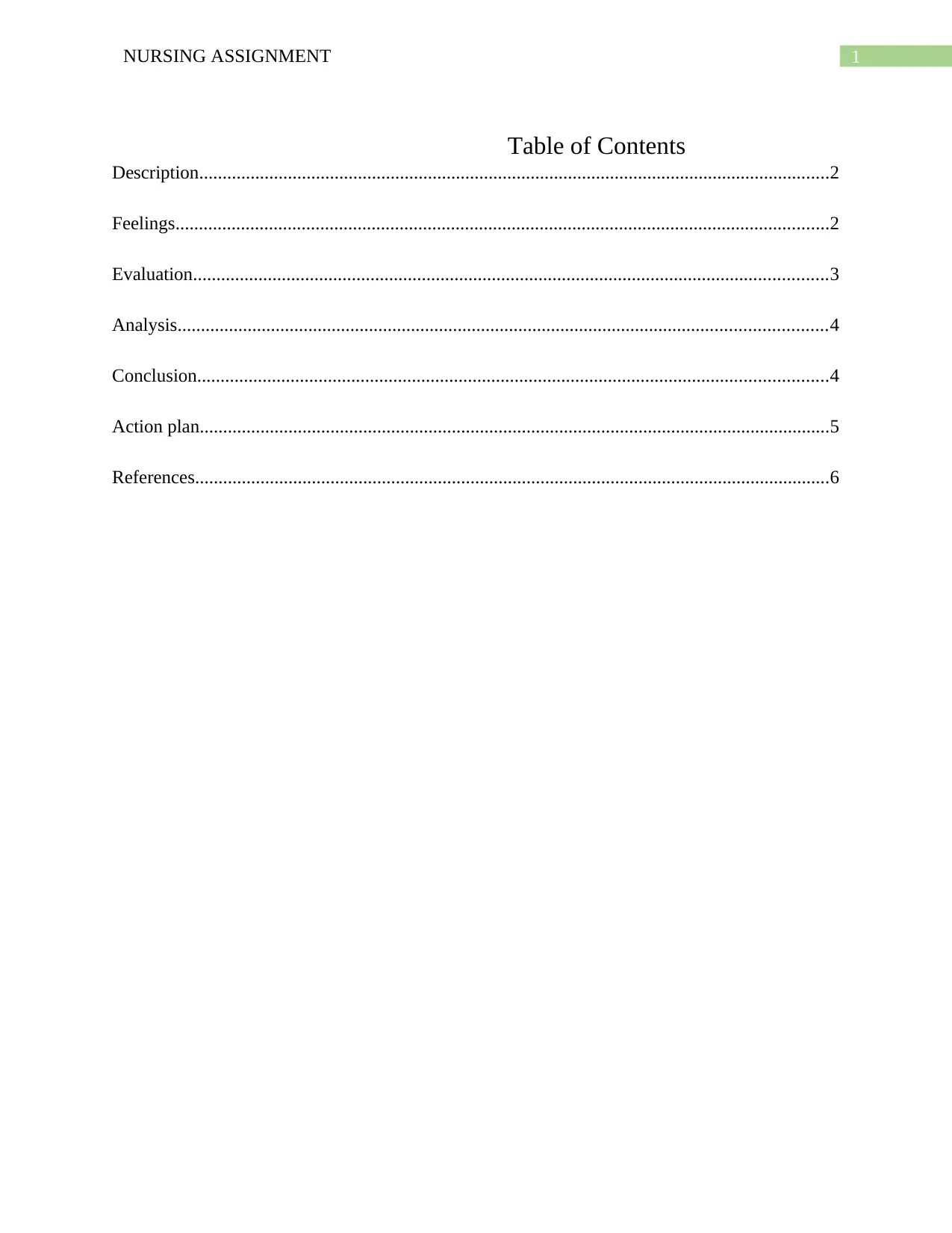
1NURSING ASSIGNMENT
Table of Contents
Description.......................................................................................................................................2
Feelings............................................................................................................................................2
Evaluation........................................................................................................................................3
Analysis...........................................................................................................................................4
Conclusion.......................................................................................................................................4
Action plan.......................................................................................................................................5
References........................................................................................................................................6
Table of Contents
Description.......................................................................................................................................2
Feelings............................................................................................................................................2
Evaluation........................................................................................................................................3
Analysis...........................................................................................................................................4
Conclusion.......................................................................................................................................4
Action plan.......................................................................................................................................5
References........................................................................................................................................6
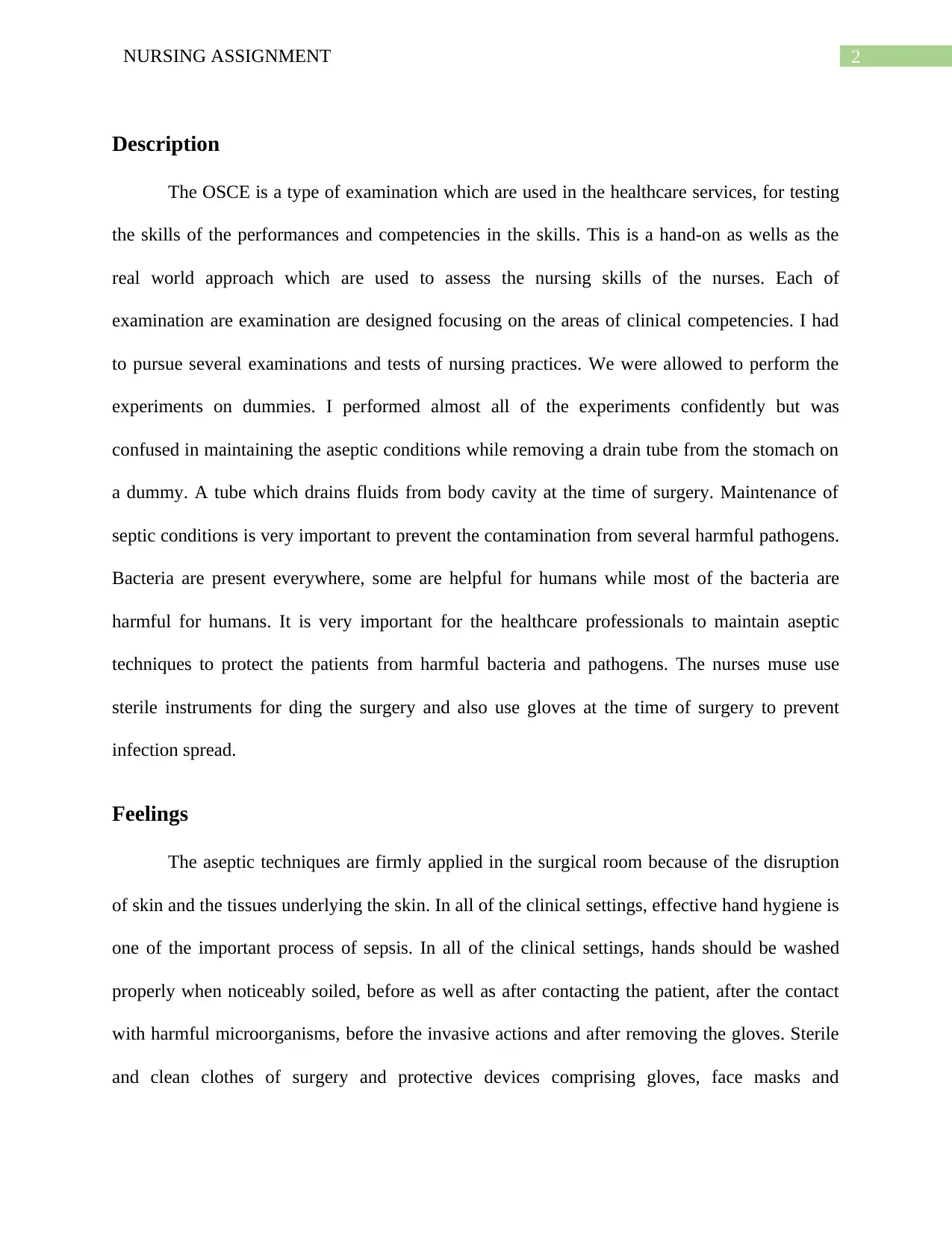
2NURSING ASSIGNMENT
Description
The OSCE is a type of examination which are used in the healthcare services, for testing
the skills of the performances and competencies in the skills. This is a hand-on as wells as the
real world approach which are used to assess the nursing skills of the nurses. Each of
examination are examination are designed focusing on the areas of clinical competencies. I had
to pursue several examinations and tests of nursing practices. We were allowed to perform the
experiments on dummies. I performed almost all of the experiments confidently but was
confused in maintaining the aseptic conditions while removing a drain tube from the stomach on
a dummy. A tube which drains fluids from body cavity at the time of surgery. Maintenance of
septic conditions is very important to prevent the contamination from several harmful pathogens.
Bacteria are present everywhere, some are helpful for humans while most of the bacteria are
harmful for humans. It is very important for the healthcare professionals to maintain aseptic
techniques to protect the patients from harmful bacteria and pathogens. The nurses muse use
sterile instruments for ding the surgery and also use gloves at the time of surgery to prevent
infection spread.
Feelings
The aseptic techniques are firmly applied in the surgical room because of the disruption
of skin and the tissues underlying the skin. In all of the clinical settings, effective hand hygiene is
one of the important process of sepsis. In all of the clinical settings, hands should be washed
properly when noticeably soiled, before as well as after contacting the patient, after the contact
with harmful microorganisms, before the invasive actions and after removing the gloves. Sterile
and clean clothes of surgery and protective devices comprising gloves, face masks and
Description
The OSCE is a type of examination which are used in the healthcare services, for testing
the skills of the performances and competencies in the skills. This is a hand-on as wells as the
real world approach which are used to assess the nursing skills of the nurses. Each of
examination are examination are designed focusing on the areas of clinical competencies. I had
to pursue several examinations and tests of nursing practices. We were allowed to perform the
experiments on dummies. I performed almost all of the experiments confidently but was
confused in maintaining the aseptic conditions while removing a drain tube from the stomach on
a dummy. A tube which drains fluids from body cavity at the time of surgery. Maintenance of
septic conditions is very important to prevent the contamination from several harmful pathogens.
Bacteria are present everywhere, some are helpful for humans while most of the bacteria are
harmful for humans. It is very important for the healthcare professionals to maintain aseptic
techniques to protect the patients from harmful bacteria and pathogens. The nurses muse use
sterile instruments for ding the surgery and also use gloves at the time of surgery to prevent
infection spread.
Feelings
The aseptic techniques are firmly applied in the surgical room because of the disruption
of skin and the tissues underlying the skin. In all of the clinical settings, effective hand hygiene is
one of the important process of sepsis. In all of the clinical settings, hands should be washed
properly when noticeably soiled, before as well as after contacting the patient, after the contact
with harmful microorganisms, before the invasive actions and after removing the gloves. Sterile
and clean clothes of surgery and protective devices comprising gloves, face masks and

3NURSING ASSIGNMENT
transparent eye and face shields must be used in order to prevent from acquiring the infection.
The asepsis in the operation room can be created in the surgical fields with drapes. The sterilized
drapes are the sterile linens which are placed upon the patient or nearby the field for delineating
the areas which are sterile. The drapes or the wrapped kits including the equipment which are
opened, such that the contents do not touch the items which are non-sterile. The drainage tubes
consisted of silastic tubes having perforations which allow the fluids to get drained from the
surgical wound zone. The drainage are collected in a collection system, specially a closed and
sterile collecting system or reservoir.
Evaluation
If I want to evaluate about my practice of removing a drain tube from the stomach, I will
valuate my weaknesses only as I was completely ruining the process of maintaining the hygiene.
I was able to maintain some of the hygienic procedures but was confused in maintaining the
hygienic conditions while removing the drain from the stomach. I followed the effective hand
hygiene procedures before removing the drain from the stomach. The next thing is confirming
the physician order correlating the amount of drainage in the last 24 hours. I was performing the
activities by wearing gloves only but was becoming nervous in releasing the suction on the
reservoir and measuring the record of drainage. It is very essential to clean the site by following
the simple dress changing procedures by following proper aseptic conditions (Park, Kim, Kim &
Yoon, 2015). This step actually prevents the infection from the place and allows the suture to be
seen easily for removal. The suture must be carefully cut and removed specifically with sterilized
suture scissors or a sterilized blade. All of these required to be done by following proper
hygienic conditions but I was becoming nervous while cleansing the site of surgery and while
cutting or removing the suture. I was becoming nervous as I was not confident whether I was
transparent eye and face shields must be used in order to prevent from acquiring the infection.
The asepsis in the operation room can be created in the surgical fields with drapes. The sterilized
drapes are the sterile linens which are placed upon the patient or nearby the field for delineating
the areas which are sterile. The drapes or the wrapped kits including the equipment which are
opened, such that the contents do not touch the items which are non-sterile. The drainage tubes
consisted of silastic tubes having perforations which allow the fluids to get drained from the
surgical wound zone. The drainage are collected in a collection system, specially a closed and
sterile collecting system or reservoir.
Evaluation
If I want to evaluate about my practice of removing a drain tube from the stomach, I will
valuate my weaknesses only as I was completely ruining the process of maintaining the hygiene.
I was able to maintain some of the hygienic procedures but was confused in maintaining the
hygienic conditions while removing the drain from the stomach. I followed the effective hand
hygiene procedures before removing the drain from the stomach. The next thing is confirming
the physician order correlating the amount of drainage in the last 24 hours. I was performing the
activities by wearing gloves only but was becoming nervous in releasing the suction on the
reservoir and measuring the record of drainage. It is very essential to clean the site by following
the simple dress changing procedures by following proper aseptic conditions (Park, Kim, Kim &
Yoon, 2015). This step actually prevents the infection from the place and allows the suture to be
seen easily for removal. The suture must be carefully cut and removed specifically with sterilized
suture scissors or a sterilized blade. All of these required to be done by following proper
hygienic conditions but I was becoming nervous while cleansing the site of surgery and while
cutting or removing the suture. I was becoming nervous as I was not confident whether I was
Secure Best Marks with AI Grader
Need help grading? Try our AI Grader for instant feedback on your assignments.
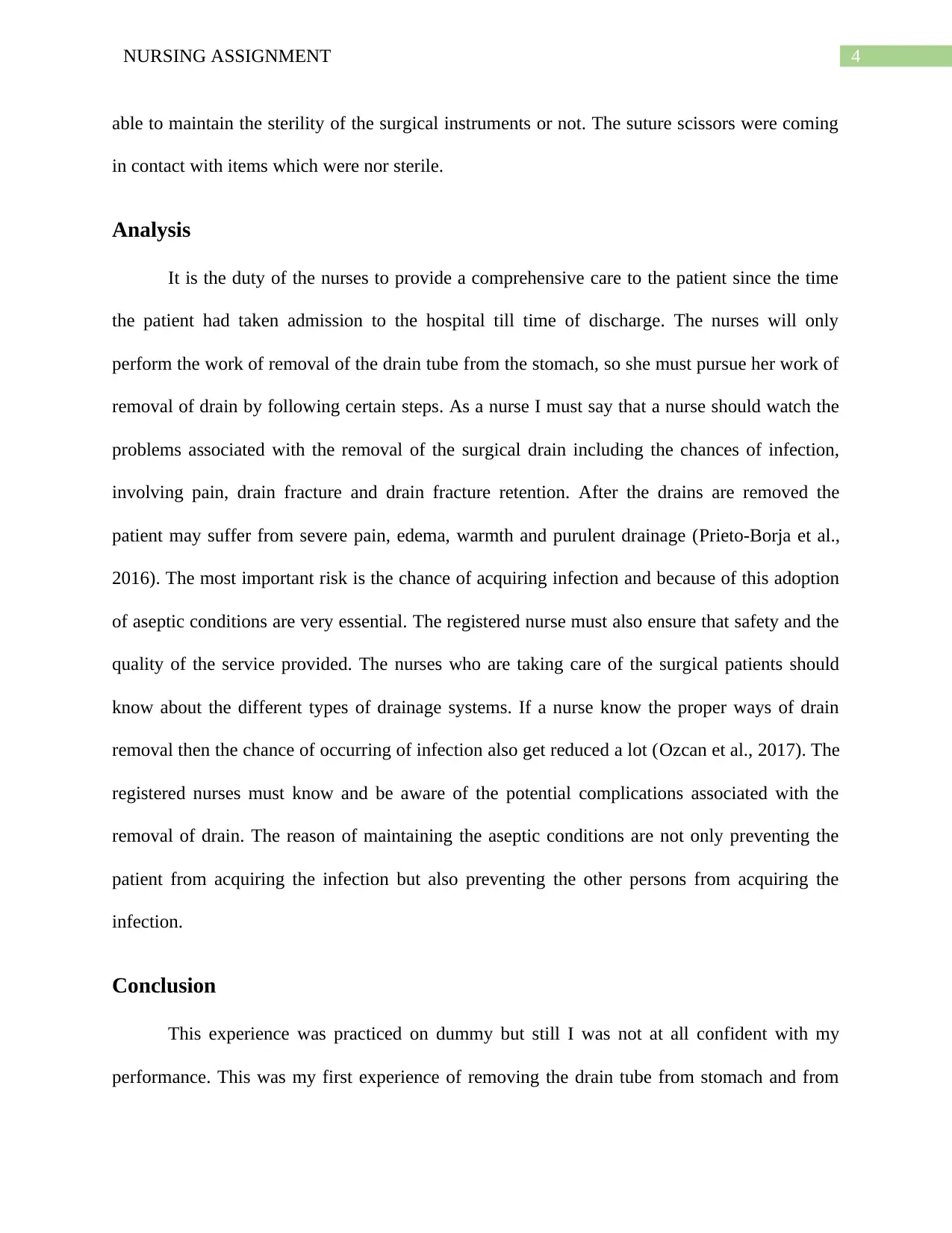
4NURSING ASSIGNMENT
able to maintain the sterility of the surgical instruments or not. The suture scissors were coming
in contact with items which were nor sterile.
Analysis
It is the duty of the nurses to provide a comprehensive care to the patient since the time
the patient had taken admission to the hospital till time of discharge. The nurses will only
perform the work of removal of the drain tube from the stomach, so she must pursue her work of
removal of drain by following certain steps. As a nurse I must say that a nurse should watch the
problems associated with the removal of the surgical drain including the chances of infection,
involving pain, drain fracture and drain fracture retention. After the drains are removed the
patient may suffer from severe pain, edema, warmth and purulent drainage (Prieto-Borja et al.,
2016). The most important risk is the chance of acquiring infection and because of this adoption
of aseptic conditions are very essential. The registered nurse must also ensure that safety and the
quality of the service provided. The nurses who are taking care of the surgical patients should
know about the different types of drainage systems. If a nurse know the proper ways of drain
removal then the chance of occurring of infection also get reduced a lot (Ozcan et al., 2017). The
registered nurses must know and be aware of the potential complications associated with the
removal of drain. The reason of maintaining the aseptic conditions are not only preventing the
patient from acquiring the infection but also preventing the other persons from acquiring the
infection.
Conclusion
This experience was practiced on dummy but still I was not at all confident with my
performance. This was my first experience of removing the drain tube from stomach and from
able to maintain the sterility of the surgical instruments or not. The suture scissors were coming
in contact with items which were nor sterile.
Analysis
It is the duty of the nurses to provide a comprehensive care to the patient since the time
the patient had taken admission to the hospital till time of discharge. The nurses will only
perform the work of removal of the drain tube from the stomach, so she must pursue her work of
removal of drain by following certain steps. As a nurse I must say that a nurse should watch the
problems associated with the removal of the surgical drain including the chances of infection,
involving pain, drain fracture and drain fracture retention. After the drains are removed the
patient may suffer from severe pain, edema, warmth and purulent drainage (Prieto-Borja et al.,
2016). The most important risk is the chance of acquiring infection and because of this adoption
of aseptic conditions are very essential. The registered nurse must also ensure that safety and the
quality of the service provided. The nurses who are taking care of the surgical patients should
know about the different types of drainage systems. If a nurse know the proper ways of drain
removal then the chance of occurring of infection also get reduced a lot (Ozcan et al., 2017). The
registered nurses must know and be aware of the potential complications associated with the
removal of drain. The reason of maintaining the aseptic conditions are not only preventing the
patient from acquiring the infection but also preventing the other persons from acquiring the
infection.
Conclusion
This experience was practiced on dummy but still I was not at all confident with my
performance. This was my first experience of removing the drain tube from stomach and from
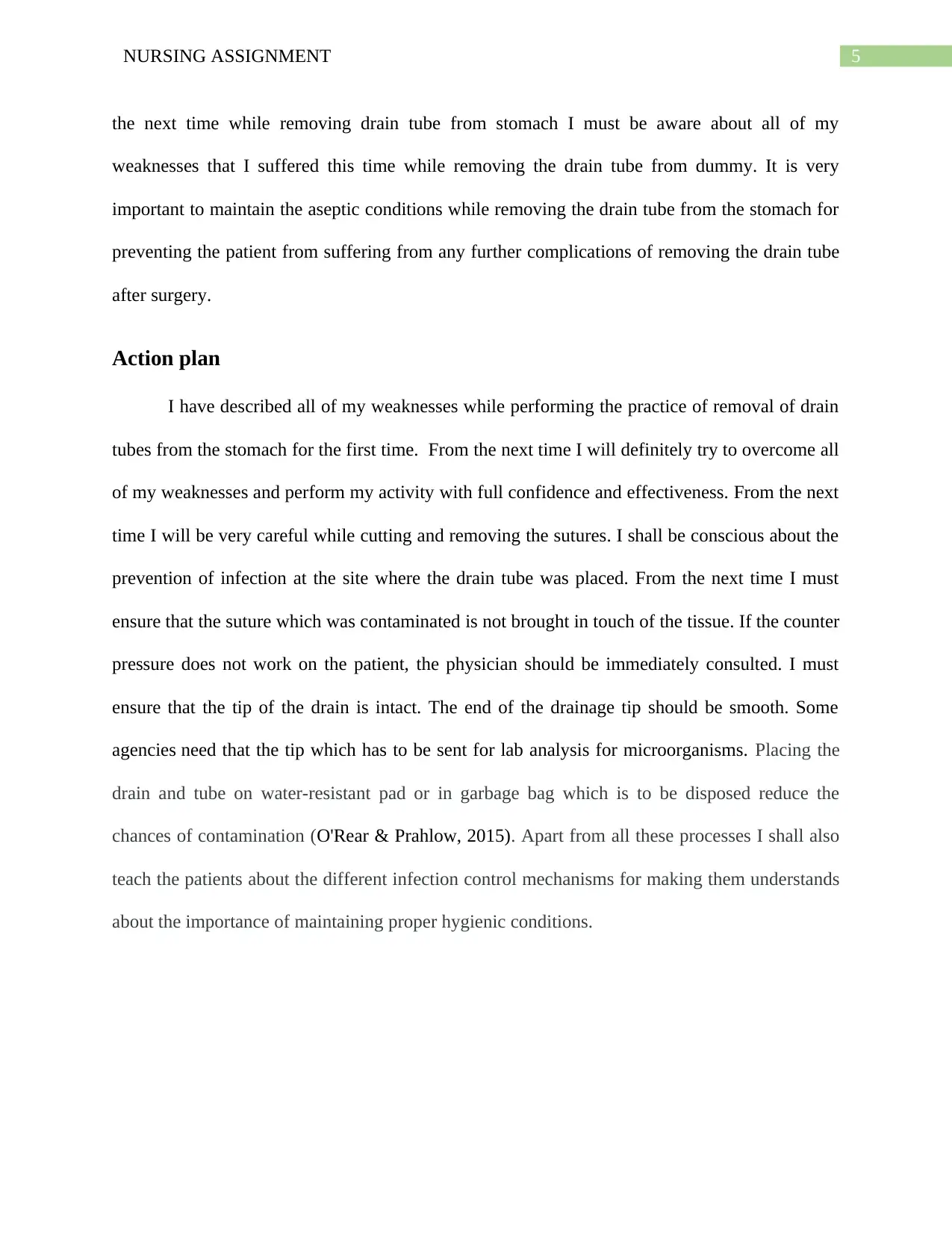
5NURSING ASSIGNMENT
the next time while removing drain tube from stomach I must be aware about all of my
weaknesses that I suffered this time while removing the drain tube from dummy. It is very
important to maintain the aseptic conditions while removing the drain tube from the stomach for
preventing the patient from suffering from any further complications of removing the drain tube
after surgery.
Action plan
I have described all of my weaknesses while performing the practice of removal of drain
tubes from the stomach for the first time. From the next time I will definitely try to overcome all
of my weaknesses and perform my activity with full confidence and effectiveness. From the next
time I will be very careful while cutting and removing the sutures. I shall be conscious about the
prevention of infection at the site where the drain tube was placed. From the next time I must
ensure that the suture which was contaminated is not brought in touch of the tissue. If the counter
pressure does not work on the patient, the physician should be immediately consulted. I must
ensure that the tip of the drain is intact. The end of the drainage tip should be smooth. Some
agencies need that the tip which has to be sent for lab analysis for microorganisms. Placing the
drain and tube on water-resistant pad or in garbage bag which is to be disposed reduce the
chances of contamination (O'Rear & Prahlow, 2015). Apart from all these processes I shall also
teach the patients about the different infection control mechanisms for making them understands
about the importance of maintaining proper hygienic conditions.
the next time while removing drain tube from stomach I must be aware about all of my
weaknesses that I suffered this time while removing the drain tube from dummy. It is very
important to maintain the aseptic conditions while removing the drain tube from the stomach for
preventing the patient from suffering from any further complications of removing the drain tube
after surgery.
Action plan
I have described all of my weaknesses while performing the practice of removal of drain
tubes from the stomach for the first time. From the next time I will definitely try to overcome all
of my weaknesses and perform my activity with full confidence and effectiveness. From the next
time I will be very careful while cutting and removing the sutures. I shall be conscious about the
prevention of infection at the site where the drain tube was placed. From the next time I must
ensure that the suture which was contaminated is not brought in touch of the tissue. If the counter
pressure does not work on the patient, the physician should be immediately consulted. I must
ensure that the tip of the drain is intact. The end of the drainage tip should be smooth. Some
agencies need that the tip which has to be sent for lab analysis for microorganisms. Placing the
drain and tube on water-resistant pad or in garbage bag which is to be disposed reduce the
chances of contamination (O'Rear & Prahlow, 2015). Apart from all these processes I shall also
teach the patients about the different infection control mechanisms for making them understands
about the importance of maintaining proper hygienic conditions.
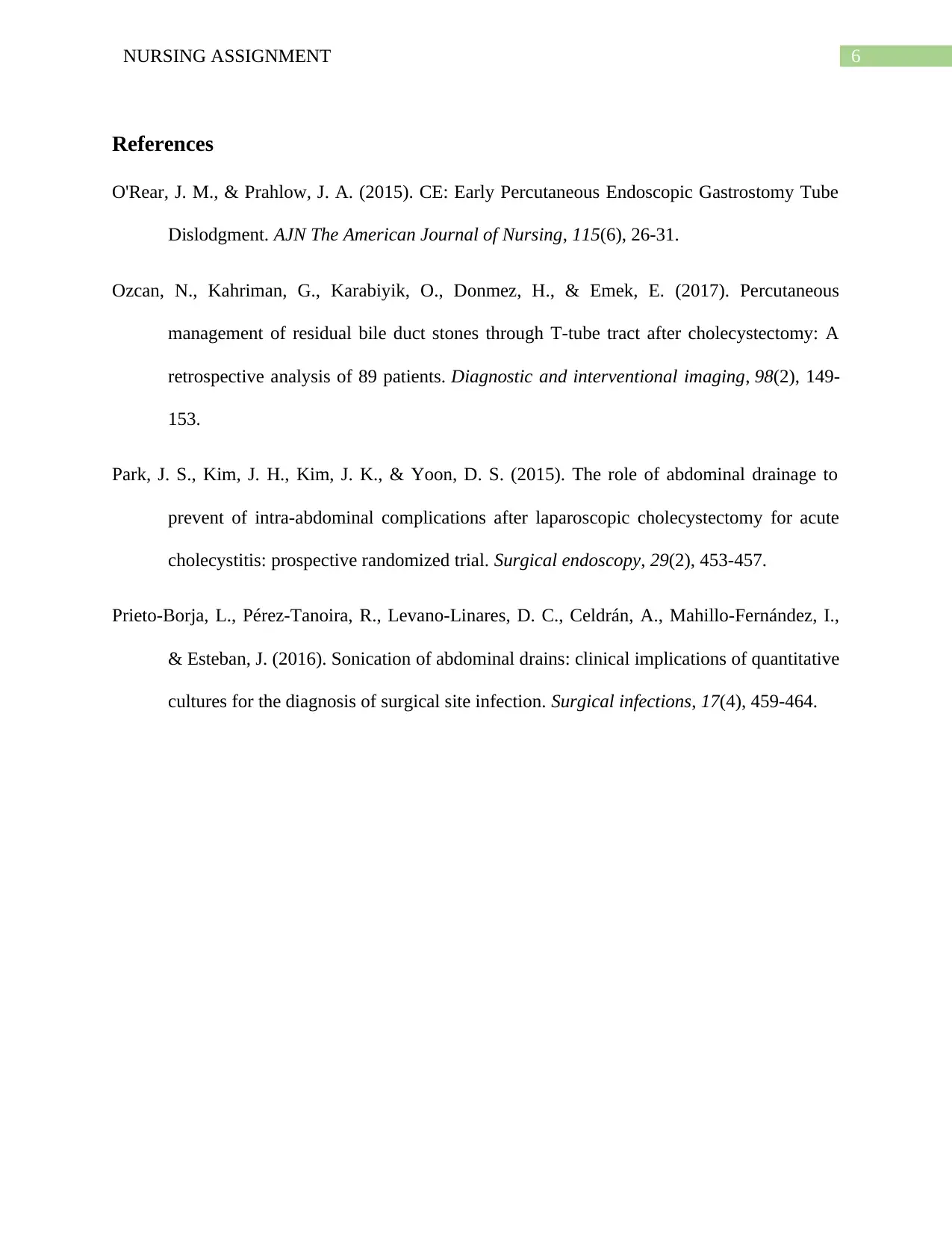
6NURSING ASSIGNMENT
References
O'Rear, J. M., & Prahlow, J. A. (2015). CE: Early Percutaneous Endoscopic Gastrostomy Tube
Dislodgment. AJN The American Journal of Nursing, 115(6), 26-31.
Ozcan, N., Kahriman, G., Karabiyik, O., Donmez, H., & Emek, E. (2017). Percutaneous
management of residual bile duct stones through T-tube tract after cholecystectomy: A
retrospective analysis of 89 patients. Diagnostic and interventional imaging, 98(2), 149-
153.
Park, J. S., Kim, J. H., Kim, J. K., & Yoon, D. S. (2015). The role of abdominal drainage to
prevent of intra-abdominal complications after laparoscopic cholecystectomy for acute
cholecystitis: prospective randomized trial. Surgical endoscopy, 29(2), 453-457.
Prieto-Borja, L., Pérez-Tanoira, R., Levano-Linares, D. C., Celdrán, A., Mahillo-Fernández, I.,
& Esteban, J. (2016). Sonication of abdominal drains: clinical implications of quantitative
cultures for the diagnosis of surgical site infection. Surgical infections, 17(4), 459-464.
References
O'Rear, J. M., & Prahlow, J. A. (2015). CE: Early Percutaneous Endoscopic Gastrostomy Tube
Dislodgment. AJN The American Journal of Nursing, 115(6), 26-31.
Ozcan, N., Kahriman, G., Karabiyik, O., Donmez, H., & Emek, E. (2017). Percutaneous
management of residual bile duct stones through T-tube tract after cholecystectomy: A
retrospective analysis of 89 patients. Diagnostic and interventional imaging, 98(2), 149-
153.
Park, J. S., Kim, J. H., Kim, J. K., & Yoon, D. S. (2015). The role of abdominal drainage to
prevent of intra-abdominal complications after laparoscopic cholecystectomy for acute
cholecystitis: prospective randomized trial. Surgical endoscopy, 29(2), 453-457.
Prieto-Borja, L., Pérez-Tanoira, R., Levano-Linares, D. C., Celdrán, A., Mahillo-Fernández, I.,
& Esteban, J. (2016). Sonication of abdominal drains: clinical implications of quantitative
cultures for the diagnosis of surgical site infection. Surgical infections, 17(4), 459-464.
1 out of 7
Related Documents
Your All-in-One AI-Powered Toolkit for Academic Success.
+13062052269
info@desklib.com
Available 24*7 on WhatsApp / Email
![[object Object]](/_next/static/media/star-bottom.7253800d.svg)
Unlock your academic potential
© 2024 | Zucol Services PVT LTD | All rights reserved.





